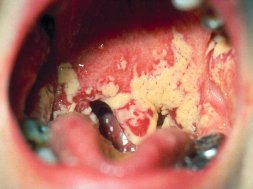
(Image in the public domain)
Interestingly enough, the yeast in question is called a dimorphic fungus. This means it can exist in one of two forms. It can exist as a collection of individual yeast cells, or it can grow threadlike structures called hyphae. These hyphae clump together to form a fungal body called a mycelium, which is what you are looking at in the gross picture above. The microscopic photo below shows you both forms of Candida albicans.

So if you have Candida albicans in your mouth, you won’t have thrush as long as the cells don’t form hyphae. If they stay in their yeast cell form, your mouth won’t look like the picture above. The interesting question, of course, is what keeps them from forming the hyphae?
Well, the complete picture is still not understood, but recently a group from the University of Oklahoma helped clear things up just a bit. It turns out that in the human mouth, there is another microorganism called Streptococcus mutans. This bacterium lives on your teeth, and it is one of the major causes of tooth decay. It converts sugar into lactic acid, which can eat away at your teeth. Thus, if you eat a high-sugar diet and don’t brush your teeth regularly, this bacterium will cause your mouth to become acidic, which will eventually destroy the enamel on your teeth.
So…you should get rid of all the Streptococcus mutans in your mouth, right? Wrong! It turns out that some S. mutans in your mouth is good, because the University of Oklahoma team found that these bacteria produce a compound called mutanobactin A, and this compound keeps yeast cells from forming hyphae.1 In other words, the bacterium keep the yeast from becoming anything but individual cells, and as a result, no thrush can form!
A commentary on this research that appears in Chemical and Engineering News states:2
The bacterium thus apparently earns its keep by protecting the host from thrush.
So too much Streptococcus mutans in your mouth can result in tooth decay, but too little S. mutans in your mouth can result in thrush. Even though S. mutans is considered pathogenic because it can cause tooth decay, it is clearly not 100% pathogenic, as it offers protection against another pathogen – the fungal form of Candida albicans.
In my mind, this “dual nature” of S. mutans is reflective of the original creation and what happened as a result of the Fall. In the initial creation, there probably weren’t any pathogens. Microorganisms existed to benefit the rest of creation in many different ways. However, when the Fall occurred, the complete harmony of the original creation was corrupted. Some organisms eventually turned pathogenic, while others continued to serve their original purpose. In some cases, such as S. mutans, perhaps the bacterium continued to do its good work (regulating the other organisms in the mouth) but also picked up the nasty habit of causing tooth decay.
This is completely speculative, of course, but I find it interesting. Even if my speculation is way off base, we know for sure that this research tells us at least one thing: The classification of an organism as pathogenic will not always be as clear-cut as we would like to believe. This is yet another indication of how incredibly complex God’s creation really is.
REFERENCES
1. P. Matthew Joyner, et al., “Mutanobactin A from the human oral pathogen Streptococcus mutans is a cross-kingdom regulator of the yeast-mycelium transition,” Organic & Biomolecular Chemistry 8:5486-5489, 2010.
Return to Text
2. S.B, “One Mouth Microbe Regulates Another,” Chemical and Engineering News October 4, 2010, p. 34.
Return to Text

I wonder, if we didn’t eat refined sugar at all, would the Streptococcus mutans be harmful at all? At any rate, it would surely be much LESS harmful.
I really don’t know, Vicki. I know that tooth decay is an ancient problem. Ancient skulls show tooth cavities, and there is an old Sumerian text (some say from 5,000 BC) that describes cavities and postulates that they are caused by a tooth worm! Thus, tooth decay didn’t start with refined sugar. At the same time, however, that doesn’t mean refined sugar couldn’t increase its likelihood.
I do know that the frequency of cavities does depend on diet, but I am not sure that any studies specifically have compared refined sugar to non-refined sugar. Most studies of which I am aware just look at carbohydrates in general and find that the more carbohydrates a population eats, the more frequently tooth decay appears.
First you make me look at that nasty picture, then you say this… “if you eat a high-sugar diet and don’t brush your teeth regularly” EW!!!! And you wonder why I don’t read and comment regularly!
Black Sheep, and yet you reward me with a comment on the article that made you say, “EW!!!!” Stop sending such mixed signals!